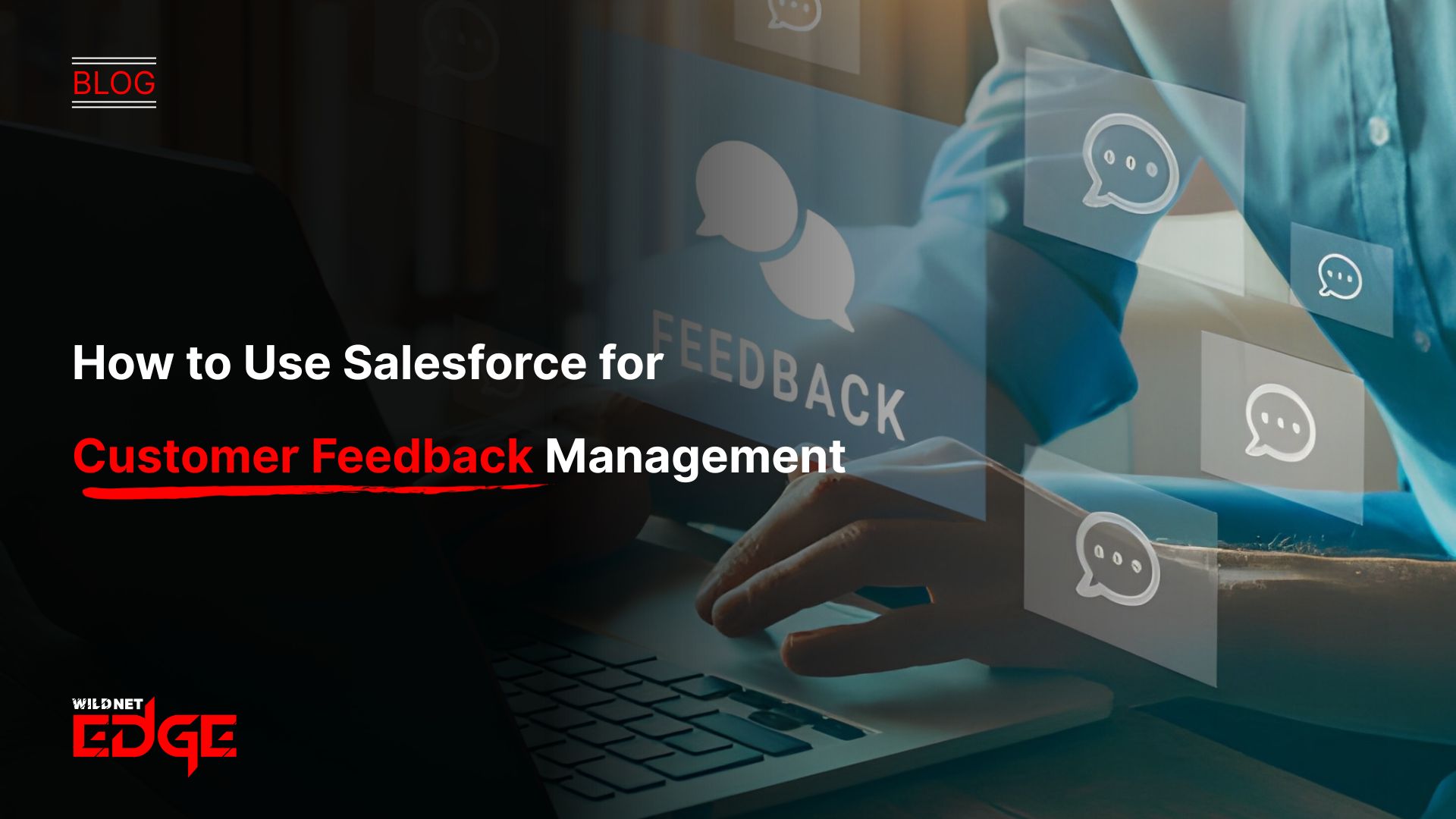TL;DR
This article explains how Salesforce feedback management centralises customer input from surveys, support cases, and social media into one unified CRM view. By leveraging tools like Salesforce Surveys, Service Cloud, and automation, businesses can turn feedback into actionable insights that improve products, enhance service quality, and strengthen customer loyalty for long-term growth.
In today’s experience-driven economy, understanding customer sentiment is helpful and essential for survival. Feedback comes through numerous channels surveys, support tickets, social media and sales conversations. Without a system to capture and analyse this valuable information, you’re flying blind. As your central customer hub, Salesforce provides the ideal platform for implementing a robust Salesforce feedback management strategy, turning scattered opinions into actionable business intelligence.
What is Salesforce Feedback Management?
Salesforce feedback management uses the platform to systematically collect, analyse, interpret, and act upon customer feedback from various sources. It involves leveraging native Salesforce tools, potential AppExchange solutions, and strategic integrations to create a unified view of customer sentiment and suggestions.
It’s about integrating feedback directly into the customer record, enabling CRM data organisation that links sentiment to specific accounts, cases, or opportunities. This allows for powerful customer insights automation and ensures that feedback drives tangible improvements across your products, services, and overall customer experience.
Why Centralise Feedback Management in Salesforce?
Managing feedback in disparate tools creates silos and makes it impossible to see the big picture. Centralising this process within Salesforce offers significant advantages:
Achieve a True 360-Degree Customer View
Linking feedback directly to customer records (Accounts, Contacts, Cases) provides invaluable context. For example, you can see a customer’s survey response alongside their purchase history and support interactions. This holistic view provides much deeper customer insights than isolated feedback data ever could.
Enable Data-Driven Decision Making
Centralised feedback data can be easily analysed using Salesforce Reports and Dashboards or Einstein Analytics. You can identify recurring issues, spot emerging trends, measure customer satisfaction (CSAT) or Net Promoter Score (NPS) over time, and quantify the impact of product changes based on feedback.
Improve Product Development and Service Quality
Direct feedback is the most valuable input for your product roadmap and service improvement initiatives. Salesforce allows you to easily tag feedback related to specific features or service interactions and share these insights directly with the relevant product or support teams. Many businesses utilise Salesforce Consulting to establish these feedback loops effectively.
Enhance Customer Relationships and Reduce Churn
Acting on feedback shows customers you value their opinions. Salesforce allows you to automate follow-ups on feedback submissions, close the loop when an issue is resolved, and proactively address concerns raised by at-risk customers, ultimately strengthening relationships and reducing churn.
Key Salesforce Features and CRM Feedback Tools
Salesforce offers several native and add-on tools that are perfect for building your feedback strategy.
- Salesforce Surveys: A native tool allowing you to create and send branded surveys triggered by specific events (e.g., case closure, opportunity won). Responses are automatically linked to relevant records.
- Service Cloud (Cases): Support cases are a rich source of unstructured feedback. Use case categorisation, keywords, and potentially Einstein Sentiment analysis to extract insights from support interactions.
- Experience Cloud (Communities): Create forums or groups where customers can provide feedback, suggest ideas, and vote on feature requests. This fosters engagement and provides qualitative insights.
- Email-to-Case / Web-to-Case: Capture feedback submitted directly via email or web forms as Cases within Service Cloud for tracking and analysis.
- Automation (Flow/Process Builder): Trigger surveys, create follow-up tasks, or update customer records based on feedback received. These tools are essential to Automate Business Processes related to feedback loops.
- AppExchange Solutions: Numerous third-party apps specialise in advanced survey capabilities, text analytics, or social media monitoring that integrate directly with Salesforce.
Implementing Your Salesforce Feedback Management Strategy
A successful strategy requires careful planning.
1. Define Your Goals and Metrics
What do you want to achieve? Improve NPS? Reduce support tickets for a specific issue? Increase feature adoption? Define clear, measurable goals for your feedback program.
2. Identify Your Feedback Channels
Map out how customers provide feedback (surveys, support, social, sales calls). Plan how you will capture or integrate data from each channel into Salesforce. A robust Salesforce Integration strategy is often required.
3. Design Your Collection Mechanisms
Configure Salesforce Surveys, set up Email-to-Case, or choose an AppExchange app. Design your surveys carefully to ask the right questions during the customer journey.
4. Build Your Analysis and Reporting
Create Salesforce Reports and Dashboards to track key metrics (CSAT, NPS, feedback themes). Use categorisation and potentially AI tools to analyse unstructured text feedback.
5. Establish Closed-Loop Processes
Define clear workflows for how feedback is routed to the appropriate teams (Product, Support, Sales) and how you will follow up with customers to acknowledge their input and inform them of actions taken. This closes the loop and shows customers their voice matters.
Salesforce Feedback Management in Action: Case Studies
Case Study 1: A SaaS Company’s NPS Program
- The Challenge: A B2B SaaS company wanted to implement a Net Promoter Score (NPS) program but needed a way to track scores over time, analyse feedback by customer segment, and automate follow-ups.
- Our Solution: We configured Salesforce Surveys to automatically send NPS surveys at key points in the customer lifecycle (e.g., 90 days post-onboarding). We used Flow to create tasks for CSMs to follow up with Detractors and built dashboards to track NPS trends by account size and industry. This was part of a larger strategic Salesforce Implementation.
- The Result: The company gained clear visibility into customer loyalty drivers. Automated follow-ups with Detractors helped resolve issues proactively, reducing churn by 10%. The NPS data also provided valuable input for their product roadmap.
Case Study 2: A Retailer Analysing Support Cases
- The Challenge: An online retailer received thousands of support emails daily, containing valuable feedback about products and website issues, but this data was unstructured and challenging to analyse systematically.
- Our Solution: We implemented Email-to-Case and used Salesforce Einstein Case Classification and Sentiment Analysis. AI automatically categorised incoming cases and identified the sentiment (positive, negative, neutral), allowing the support team to prioritise urgent issues and the product team to filter feedback related to specific product lines easily. Custom solutions often benefit from Salesforce Development Services.
- The Result: Support team efficiency increased by 20% through automated categorisation. The product team gained near-real-time insights into customer pain points, allowing them to address recurring issues much faster and demonstrating compelling customer insights automation.
Our Technology and Expertise
We leverage the full suite of Salesforce tools for feedback management.
- Core Platforms: Sales Cloud, Service Cloud, Experience Cloud, Salesforce Surveys, Marketing Cloud
- AI: Einstein Sentiment, Einstein Case Classification
- Automation: Salesforce Flow, Process Builder, Apex
- Analytics: Salesforce Reports & Dashboards, Tableau
- Integration: MuleSoft, AppExchange Partners
Conclusion
Implementing a structured Salesforce feedback management system transforms customer opinions from noise into a strategic asset. By centralising data, leveraging powerful CRM feedback tools, and embracing customer insights automation, you can build a more customer-centric organisation that continuously learns and improves. Acting on feedback is the key to building loyalty and driving sustainable growth.
Ready to build a feedback loop that fuels your success? At Wildnet Edge, our AI-first approach enables us to create intelligent systems that collect feedback, analyse sentiment, and automate actions, ensuring you derive maximum value from your customer interactions.
FAQs
Make it easy and timely. Trigger short surveys immediately after key interactions (like a support case closure). Offer small incentives (like entry into a draw). Clearly communicate how you use feedback to make improvements—showing customers their voice leads to change and encourages participation.
CSAT (Customer Satisfaction) typically measures satisfaction with a specific interaction (e.g., a support call) using a scale like 1-5. NPS (Net Promoter Score) measures overall loyalty to the brand (“How likely are you to recommend…”) on a 0-10 scale. Use CSAT for transactional feedback and NPS for relational feedback. Both are valuable CRM feedback tools.
Salesforce Einstein Sentiment and Intent tools can automatically analyse text comments to determine whether they are positive or negative and identify the underlying topic or intent. For deeper analysis, you might integrate with specialised NLP tools via Salesforce Integration.
A closed-loop process means you not only collect feedback but also act on it and then communicate back to the customer (or customer base) about the actions taken. This shows customers their feedback wasn’t ignored and encourages future participation.
Yes, this is a common and effective strategy. You can build feedback forms or survey prompts into your application and use Salesforce APIs to push that data directly into custom objects or standard objects (like Cases) linked to the customer record.
Use Salesforce reporting to identify trends. Focus on feedback themes that are mentioned frequently, impact a large number of users, relate to critical parts of the user journey (like checkout or core functionality), or come from your most valuable customer segments.
Experience Cloud is excellent for gathering qualitative feedback and fostering discussion. You can create “Ideas” forums where users submit feature requests and vote on them, or discussion groups where they can share pain points and best practices. This provides rich context beyond quantitative survey data.

Nitin Agarwal is a veteran in custom software development. He is fascinated by how software can turn ideas into real-world solutions. With extensive experience designing scalable and efficient systems, he focuses on creating software that delivers tangible results. Nitin enjoys exploring emerging technologies, taking on challenging projects, and mentoring teams to bring ideas to life. He believes that good software is not just about code; it’s about understanding problems and creating value for users. For him, great software combines thoughtful design, clever engineering, and a clear understanding of the problems it’s meant to solve.
 sales@wildnetedge.com
sales@wildnetedge.com +1 (212) 901 8616
+1 (212) 901 8616 +1 (437) 225-7733
+1 (437) 225-7733































